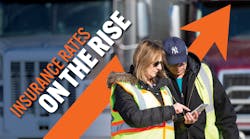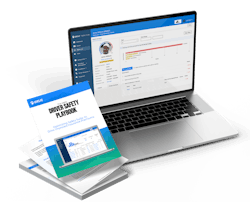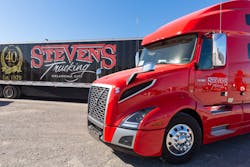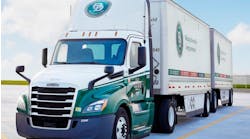Fleets face social inflation and high insurance costs, but they have some control
Over the last decade, per-mile insurance premium costs for commercial motor carriers have increased by almost 50%, according to data from the American Transportation Research Institute.
Although that equates to roughly 5% increases for fleets each year and might not seem so daunting when it’s all broken down, those increases add up. And continual surges in insurance premiums could pack an even harder punch when fleets also are working in an environment of lower freight rates but higher operating costs.
There are so many variables that play a role in rising insurance rates, many of which fleets have little to no control over. Lately, social inflation has been a key contributor to the higher costs fleets are seeing.
See also: Deciphering the calculus of trucking insurance
About 15 years ago, the commercial auto industry was profitable before hitting a bottom in the late 2000s, Nick Saeger, Sentry Insurance’s assistant VP of transportation products and pricing, told FleetOwner. In the early 2010s, that bottom prompted insurance companies to increase rates.
“Rates were behind where costs were going,” Saeger said. “Combined ratios were starting to increase about that timeframe. Right at the point where actuaries started noticing that and started increasing rates a little bit is when costs started skyrocketing beyond anything that we really anticipated.”That was also about the time when the trucking industry started seeing higher attorney involvement and changes in the way attorneys were trying cases—think reptile theory, nuclear verdicts, and tactics deployed to prey on the more emotional aspects of cases rather than the facts.
This played into the broader social inflation landscape, where trial lawyers began looking at new ways to reapportion wealth.
"Regardless of the magnitude of the increase, the root causes are tied to underlying medical costs, parts and labor rate inflation, along with the gravitational pull on most liability losses of so-called nuclear verdicts," Chris Homewood, SVP, head of commercial auto for Hudson Insurance Group, explained. "The simple truth is that insurance companies are put in a position to pay more for losses today than in the past, above and beyond normal inflation, due to a greater willingness of juries to award outsized sums when cases are tried. This has an additional inflationary effect on losses that are never tried in court."
"In the current legal environment, the amounts of limits purchased can have an influence on the ultimate value of similar losses, meaning the same type of loss for a fleet with $1 million in liability limits often settles for less than for a fleet with $5 million in limits," Homewood added.
Reid Spitz, chief product officer and co-founder of High-Definition Vehicle Insurance (HDVI), also indicated that the primary driver of insurance costs is social inflation. He, too, pointed to litigation tactics and a rise in nuclear verdicts as the main culprits.
“Those huge jury verdicts pull up the average costs of even the smaller claims because insurance companies would rather settle a claim than go to court,” Spitz said. “There has been a large focus on the trucking industry by the plaintiff bar and that has just increased the cost of claims dramatically."
In addition to these social inflation factors, insurance rates have risen amid a proliferation of increased distracted driving incidents and as truck driver recruiting, retention, and turnover continue to challenge the industry.
“All this came together at once to lead to this increase in rates over the last 10 years or so,” Sentry’s Saeger noted. “Fleets have some control, but that’s not going to say that rates aren’t going to increase. In even the most perfect of circumstances, rates are always going up. At times you are at mercy of the entire system.”
Being at the mercy of the insurance system doesn’t sound so reassuring if you haul freight for a living. So, what can fleets do to potentially increase their chance of getting the best possible rate in a volatile market? The good news, it can be done. It starts with having solid safety practices, hiring good drivers, continuous driver training, and even implementing new safety technologies to help reduce overall risk.
How underwriters evaluate risk
Despite these precipitous rises in premiums, insurance companies’ profitability has decreased, and their losses are growing.
To date, the primary tool that actuaries and insurance companies have had to try to regain profitability is to raise rates, HDVI’s Spitz explained. Industrywide adoption of telematics and ELD data, however, are helping insurance providers like HDVI fragment the market a little better.
“You can understand who really is a good risk that is deserving of a better premium and who is a more difficult risk that may require a higher premium,” Spitz said. “With that kind of segmentation from the telematics data, we are able to provide a roughly 20% savings on the base premium for motor carriers on a monthly basis.”
Traditionally, trucking insurance underwriters are looking at a number of different factors when they are evaluating risk, including losses from prior accidents, and driver and motor vehicle records, which might be a snapshot in time of an instance over a three-year period. Underwriters also look at inspections and violations flagged by the Federal Motor Carrier Safety Administration.
See also: HDVI launches second-gen telematics-based fleet insurance offering
Keeping that in mind, HDVI has taken a more fleet-tailored view of assessing risk in the underwriting process. HDVI underwriters collect tens of thousands of data points of activity on every vehicle they cover, scrutinizing all harsh events, speeding, where the trucks are driven, and routes to get a more high-definition picture of carrier risk.
“Holistically, it’s a much richer set of data that we use when evaluating a trucking company,” Spitz noted. “When you don’t have granular data to evaluate risk, you basically have to raise rates on everybody because you can’t distinguish between the better risk and the worst risk in terms of how they will perform. When you have this rich set of data that you can use, it does add deeper value to risk assessment.”
One safety and driver-management solutions provider has taken a whole new approach to fleet insurance. Idelic has launched the Idelic Insurance Agency to provide Safety Suite fleet customers with more customized insurance coverage using an underwriting process that leverages driver behavioral data.
The Idelic Insurance Agency lets fleets use technology and processes to lower losses, and in turn, renewals based on successful results. The program combines Idelic’s Safety Suite offering, which first aggregates driver risk data and identifies high-risk drivers using machine learning models, and its Driver Safety Playbook, a guide that aims to engage drivers through coaching and step-by-step professional development plans.“Our approach is to partner with the fleet to help them reduce accidents,” explained Michael Gramm, Idelic’s senior VP of insurance. “At the end of the day, the premium and overall costs are driven by the accidents they are having and how severe the accidents are.”
Idelic’s chief technology officer, Brian Filip, added that the agency uses all the same considerations as any traditional insurer, but Safety Suite’s telematics and camera data provide an additional layer to customize coverage.
“By bringing all those things together, we help them better see all the risks within their fleet,” Filip added. “And they we combine that with our plans to help them actually change driver behavior in the long term and drive down bad risk.”
Filip also noted that many fleets know they have valuable data to share, but they still aren’t aware of how they can use their telematics data to change their risk.
“Most people aren’t actively using that data on the insurance side,” Filip explained. “There are some programs out there, but I think they are struggling to make the connection between raw data and actual insight and how to use that to change behavior. That’s the problem that we are actually trying to solve.”
As a former fleet safety director and truck driver, Mike Yonka, director of safety services and loss control for transportation at Sentry Insurance, said he also typically sees minimal use of telematics data across the board.
“Most motor carriers don’t understand the amount of data that is out there, especially with ELDs,” Yonka said. “We can look at hard brakes, we can look at hard cornering, we can look at hard acceleration—that data is there for them to evaluate their drivers. They can look at the camera systems, too, to see what’s going on with the drivers to help the driver improve. A very large majority of the trucking industry doesn’t understand the amount of data out there or the amount of data that they have access to help them improve their operations.”At Sentry, Saeger explained that actuarily driven rates are state-regulated and could differ based on the territory in which fleets are operating. Sentry, whose transportation consultants are all former fleet safety directors or trucking professionals, also considers prior crash frequency, safety scores, driver training, and safety practices in its underwriting process.
Yonka added that for some of Sentry’s larger fleet customers, the insurance provider will perform a presurvey that evaluates the risk in an underwriting report, which is a tool underwriters used to determine if a fleet customer is a good risk or not.
“Sometimes that’s when we figure out that they might not be doing everything they should be doing,” Yonka noted. “We look at training, hiring, vehicle maintenance, whether they do safety meetings and how often they do them.”
How fleets can take control
When it comes to insurance premiums and overall safety costs, fleets can control the composition of their driver pool in terms of violation history and level of experience, according to Hudson Insurance Group's Homewood. "They can also control where they run their assets (freight lanes), the level of technology (cameras, telematics, lane departure/collision warning, etc.), coupled with the management of information retained from this technology and their culture of safety," Homewood added.
Years ago, Nationwide Insurance recognized that certain types of technologies—telematics, forward- and inward-facing cameras, and anti-distracted-driving systems—when used correctly, could benefit motor carriers.
“We were early adopters of video telematics for our customers,” Phillip Wigginton, national director, E&S Commercial Auto Risk Management Services at Nationwide, told FleetOwner. “Then you see technology like automatic braking and adaptive cruise control, and I think people are just starting to recognize that these technologies will help reduce crash frequency and severity. That’s the ultimate goal of what we do in risk management.”
See also: How dash cams, driver coaching tools could help fleets reduce costs
A lot of what Nationwide works on with their commercial fleet customers is safety program best practices, Wigginton noted. During risk assessments, consultants also will learn more about specific fleet pain points, like finding and retaining good drivers, equipment repairs, and parts shortages.
Nationwide analyzes and works with fleets to enhance their safety programs and adoption of new safety technologies. Nationwide’s commercial fleet customers also have access to NoCell’s distracted driving management platform. NoCell’s technology helps remove distraction risks by disabling disruptive apps and cellphone capabilities while drivers are rolling, enabling carriers to carry out custom mobile device policies with their fleets.
Oklahoma-based carrier and Nationwide customer Stevens Trucking utilizes NoCell’s technology to better manage fleet safety and costs overall. Cole Stevens, chief strategy officer at Stevens, previously told FleetOwner that NoCell is not “just some cookie-cutter methodology for blocking apps that aren’t necessarily work-related apps because there’s a lot of GPS and truck-stop apps that a driver may need to still see.” He added that his drivers can still make calls using Bluetooth headsets.Sentry Insurance’s Yonka stressed that at the end of the day, fleet safety is a multifaceted approach that starts from the top of the company’s C-suite and doesn’t compromise on safety.
“Even when I was in the trucking industry—we’re talking 15 years ago—there was a shortage of drivers,” Yonka noted. “Carriers tend to compromise if they have empty trucks and need to hire drivers, so they might cut back on their hiring criteria.”
Yonka urged fleets not to waiver when it comes to safety.
“If you have a good, safe quarter with no violations, no speeding, and no accidents, reward drivers for that,” Yonka advised.
Sentry’s Saeger added that, when fleets put in the work, they ultimately can see results that lead to better insurance prices. And for the fleets that take safety to heart and have fewer incidents, they might want to consider raising their deductibles and taking on more risk.
“You’ll see that with the companies that think they are doing a good job,” Saeger said. “They know there is a rising cost of insurance throughout the industry, but they think they are better than the average trucking company, so they take on some of that risk through a higher deductible and save more money upfront by increasing their risk. We’ve found that to be successful tool for companies willing to make that investment.”








